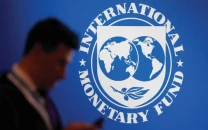Our industrial stagnation in a region of growth
Industrial development is the backbone of progress in today's world, powering economic growth, innovation

Pakistan-China relations are often discussed with pride and optimism, hailed as a model of strategic partnership, especially under the banner of CPEC. Yet a crucial question remains largely unasked: has Pakistan ever seriously tried to understand what fundamentally makes China rise to the forefront of global industrial power while Pakistan stagnates or falls behind?
Industrial development is the backbone of progress in today's world, powering economic growth, innovation and social uplift. A vibrant industrial sector raises productive capacity, creates employment and provides the structural foundation for sustained prosperity.
China's industrial breakthrough was no coincidence. It began with identifying critical weaknesses that needed urgent reform: outdated transport networks, unreliable and insufficient power supply, limited digital infrastructure and an underdeveloped industrial workforce lacking advanced technical skills. China's leaders understood that without addressing these fundamentals, industrial growth would remain stunted.
Step by step, China invested heavily in building a state-of-the-art transportation network, including national highways and a high-speed rail system to facilitate rapid movement of goods and labour across vast distances. It developed a reliable and abundant power supply system with advanced ultrahigh voltage transmission lines to ensure that factories and industries had the energy they needed. It built one of the world's most advanced digital infrastructures and created a controlled but expansive internet ecosystem that fuelled domestic innovation while maintaining strategic governance. And it focused on workforce development through hands-on training.
Crucially, the meticulous integration of all these elements allowed Chinese firms to rapidly innovate, scale emerging technologies like electric vehicles and renewable energy and establish China as a resilient technological powerhouse on the global stage.
India's industrial experience also went through similar impediments. India once faced infrastructure bottlenecks, bureaucratic red tape and power shortages, impeding industrial growth. India too emulated the strategy of modernising transport, energy and digital infrastructure while promoting labour reforms and technological adoption across sectors. Initiatives like 'Make in India' have transformed the country into a global manufacturing hub by attracting investment, upgrading skills and streamlining regulations.
Now, consider Pakistan's position. Despite being China's closest neighbour and an official partner in CPEC for over a decade, Pakistan's industrial sector shows limited progress because Pakistan has refused to take the path both India and China had taken to bolster its industrial growth.
Despite producing abundant electricity, Pakistan has one of the most outdated and chronically unproductive — yet most expensive — power sectors. In short, weak physical infrastructure, chronic power shortages, outdated machinery and a shortage of skilled industrial labour raise production costs and hinder scalability.
As of the latest reporting, Pakistan's GDP grew by 2.68% in FY25, falling short of the government's own target of 3.6%. This modest growth is due to contraction in industrial output: large-scale manufacturing fell by 0.74% in the same period, with key sectors like cement, steel, chemicals and machinery posting steep declines of up to 35%. The food sector contracted 1.83%, chemicals by over 3%, non-metallic minerals by nearly 8%, iron and steel by 9% and electrical equipment by almost 12% — illustrating the structural weakness of the country's industrial base.
According to reports by Pakistan Bureau of Statistics and World Bank, Pakistani workers are less productive than their counterparts in neighbouring countries due to inadequate technical and vocational skills. The overall gap between the demand and supply of skilled workforce in Pakistan is estimated at around 67%.
The lesson from China and India is clear: industrial strength arises not from short-term fixes or isolated subsidies, but from building integrated infrastructure, human capital and governance.
There is another lesson in it: China's model is supported by a rule of law and accountability system which, while not free of corruption, enforces sustainability with strict laws and punishments ensuring investments are productive and risks of waste minimised. The same is true for India. Its 1990s reforms reduced government intervention, strengthened the private sector and established a more market-friendly yet accountable environment — leading to steadier industrial growth.
In Pakistan, as World Bank has noted, many investors are now choosing to put their money in foreign markets instead of investing at home. This is happening because the government keeps changing its policies, creating new institutions like the Special Industrial Facilitation Centre and weakening the ones that already exist. On top of that, political instability, confusing tax rules and misuse of accountability bodies like NAB — often used to go after businesses instead of supporting them — have made the investment climate even worse.
Let's look at some statistics to understand the depth and scale of this malice.
According to the UNCTAD World Investment Report 2025, Pakistan's outward foreign direct investment (FDI) reached $2.7 billion in 2024, reflecting a 9.8% increase from the previous year, with the total FDI stock abroad standing at $2.698 billion by mid-2025.
In the emergent global race for technological and industrial growth, Pakistan's choice is stark. It can cling to fractured governance and policy inconsistency, or muster the collective will to build a resilient industrial base inspired by its closest neighbours.
The prosperity of millions hinges on this decision. As we speak, nearly half of Pakistan's 255 million citizens struggle to secure even two meals a day. The scale of poverty is staggering - measured in hunger, instability and lost potential.
Celebrating China's friendship must go beyond ceremony; it must lead to a deeper understanding of the systems that enabled China's rise. At the same time, Pakistan must move past the habit of viewing India solely through the lens of rivalry.
If Pakistan is serious about stability and growth, it must think strategically and rise above old patterns.














COMMENTS (2)
Comments are moderated and generally will be posted if they are on-topic and not abusive.
For more information, please see our Comments FAQ